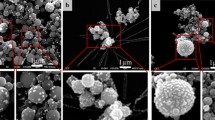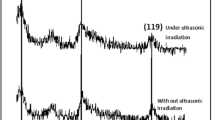Abstract
The production of nano-TiO\(_{2}\) is a time consuming process, due to a long peptization phase. In the past years, ultrasound has become more and more popular as a tool for improving chemical processes. With its ability to enhance mass transfer and deagglomeration, it is a promising technology to investigate the reduction of the production time of nano-TiO\(_{2}\) in a size range of 40 nm. In the present work, the effect of ultrasound on the hydrodynamic diameter during the production of nano-TiO\(_{2}\) is investigated. Additionally, different precursors are used in combination with ultrasound to find the optimal process conditions. The obtained data shows a significant reduction of the production time for nano-TiO\(_{2}\), especially when precursors with long alkoxide chains are used.








Similar content being viewed by others
References
Haider AJ, Jameel ZN, Al-Hussaini IHM (2019) Review on: titanium dioxide applications. Energy Procedia 157:17–29. https://doi.org/10.1016/j.egypro.2018.11.159
McNamara K, Tofail SAM (2017) Nanoparticles in biomedical applications. Adv Phys: X 2(1):54–88. https://doi.org/10.1080/23746149.2016.1254570
Claes T, Dilissen A, Leblebici ME, Van Gerven T (2019) Translucent packed bed structures for high throughput photocatalytic reactors. Chem Eng J 361:725–735. https://doi.org/10.1016/j.cej.2018.12.107
Lee SY, Park SJ (2013) TiO2 photocatalyst for water treatment applications. J Indust Eng Chem 19(6):1761–1769. https://doi.org/10.1016/j.jiec.2013.07.012
Beydoun, D, Amal, R, Low, G, McEvoy, S, Role of nanoparticles in photocatalysis. J Nanoparticle Res 1(4):439–458. https://doi.org/10.1023/A:1010044830871
Minerals Yearbook, volume I, Metals and Minerals. USGS Unnumbered Series, U.S. Geological Survey, Reston, VA (2018). https://doi.org/10.3133/mybvI
Fries R, Simko M (2012) (Nano-)Titanium dioxide (Part I): Basics. Prod, Appl
Akbal F (2005) Photocatalytic degradation of organic dyes in the presence of titanium dioxide under UV and solar light: effect of operational parameters. Environ Prog 24(3):317–322. https://doi.org/10.1002/ep.10092
Choi YL, Seon-Hwa K, Song YS, Lee DY (2004) Photodecomposition and bactericidal effects of TiO2 thin films prepared by a magnetron sputtering. J Materials Sci 39(18):5695–5699. https://doi.org/10.1023/B:JMSC.0000040078.09843.cb
Joo, J, Kwon, SG, Yu, T, Cho, M, Lee, J, Yoon, J, Hyeon, T, Large-Scale synthesis of TiO2 nanorods via nonhydrolytic Sol-Gel Ester elimination reaction and their application to photocatalytic inactivation of E. coli. J Phys Chem B 109(32):15,297-15,302 (2005). https://doi.org/10.1021/jp052458z
Anpo M, Shima T, Kodama S, Kubokawa Y (1987) Photocatalytic hydrogenation of propyne with water on small-particle titania: size quantization effects and reaction intermediates. J Phys Chem. https://doi.org/10.1021/j100300a021
Chen X, Mao SS (2007) Titanium dioxide nanomaterials: synthesis, properties, modifications, and applications. Chem Rev 107(7):2891–2959. https://doi.org/10.1021/cr0500535
Kandiel TA, Feldhoff A, Robben L, Dillert R, Bahnemann DW (2010) Tailored titanium dioxide nanomaterials: anatase nanoparticles and brookite nanorods as highly active photocatalysts. Chem Materials 22(6):2050–2060. https://doi.org/10.1021/cm903472p
Ismail, AA, Kandiel, TA, Bahnemann, DW, Novel (and better?) titania-based photocatalysts: brookite nanorods and mesoporous structures. J Photochem Photobiology A: Chem 216(2-3), 183–193 (2010). https://doi.org/10.1016/j.jphotochem.2010.05.016
Venkatachalam N, Palanichamy M, Murugesan V (2007) Sol-gel preparation and characterization of nanosize TiO2: its photocatalytic performance. Materials Chem Phys 104(2):454–459. https://doi.org/10.1016/j.matchemphys.2007.04.003
Livage, J, Henry, M, Sanchez, C, Sol-gel chemistry of transition metal oxides. Progress in Solid State Chemistry 18(4):259–341. https://doi.org/10.1016/0079-6786(88)90005-2
Nagpal, VJ, Davis, RM, Riffle, JS, In situ steric stabilization of titanium dioxide particles synthesized by a sol-gel process. Colloids and Surfaces A: Physicochemical and Engineering Aspects 87(1):25–31. https://doi.org/10.1016/0927-7757(93)02735-W
Vorkapic D, Matsoukas T (1998) Effect of temperature and alcohols in the preparation of titania nanoparticles from alkoxides. J American Ceramic Soc 81(11):2815–2820. https://doi.org/10.1111/j.1151-2916.1998.tb02701.x
Mahshid S, Askari M, Ghamsari MS (2007) Synthesis of TiO2 nanoparticles by hydrolysis and peptization of titanium isopropoxide solution. J Materials Process Technol 189(1):296–300. https://doi.org/10.1016/j.jmatprotec.2007.01.040
Mahy JG, Lambert SD, Geens J, Daniel A, Wicky D, Archambeau C, Heinrichs B (2018) Large scale production of photocatalytic TiO\(_{\rm 2 }\) coating for volatile organic compound (VOC) air remediation. AIMS Materials Sci 5(5):945–956. https://doi.org/10.3934/matersci.2018.5.945
Nguyen VS, Rouxel D, Hadji R, Vincent B, Fort Y (2011) Effect of ultrasonication and dispersion stability on the cluster size of alumina nanoscale particles in aqueous solutions. Ultrasonics Sonochem 18(1):382–388. https://doi.org/10.1016/j.ultsonch.2010.07.003
Sato K, Li JG, Kamiya H, Ishigaki T (2008) Ultrasonic dispersion of TiO2 nanoparticles in aqueous suspension. J American Ceramic Society 91:2481–2487
Kumar, VV, Ultrasonic-assisted de-agglomeration and power draw characterization of silica nanoparticles. Ultrasonics Sonochemistry 65:105,061 (2020). https://doi.org/10.1016/j.ultsonch.2020.105061
Neppolian B, Wang Q, Jung H, Choi H (2008) Ultrasonic-assisted sol-gel method of preparation of TiO2 nano-particles: characterization, properties and 4-chlorophenol removal application. Ultrasonics Sonochemistry 15(4):649–658. https://doi.org/10.1016/j.ultsonch.2007.09.014
Yu JC, Zhang L, Yu J (2002) Direct Sonochemical Preparation and Characterization of Highly Active Mesoporous TiO2 with a Bicrystalline Framework. Chemistry of Materials 14(11):4647–4653. https://doi.org/10.1021/cm0203924
Huang W, Tang X, Wang Y, Koltypin Y, Gedanken A (2000) Selective synthesis of anatase and rutile via ultrasound irradiation. Chemical Communications 15:1415–1416. https://doi.org/10.1039/B003349I
G. Baldi, M. Bitossi, A. Barzanti. Method for the preparation of aqueous dispersions of tio2 in the form of nanoparticles, and dispersions obtainable with this method (2010)
Oskam, G, Nellore, A, Penn, RL, Searson, PC, The growth kinetics of TiO2 nanoparticles from titanium(IV) alkoxide at high water/titanium ratio. J Phys Chem B 107(8):1734–1738. https://doi.org/10.1021/jp021237f
Mohammadi S, Harvey A, Boodhoo KVK (2014) Synthesis of TiO2 nanoparticles in a spinning disc reactor. Chemical Engineering Journal 258:171–184. https://doi.org/10.1016/j.cej.2014.07.042
Leung, R, Shah, DO, Dynamic properties of micellar solutions: I. Effects of short-chain alcohols and polymers on micellar stability. Journal of Colloid and Interface Sci 113(2):484–499 (1986). https://doi.org/10.1016/0021-9797(86)90183-9
Barton, AFM, Haulait-Pirson, MC (eds.), Alcohols with water, 1st edn. No. v. 15 in Solubility data series (Pergamon, Oxford ; New York, 1984)
Suslick KS, Price GJ (1999) Applications of ultrasound to materials chemistry. Annual Rev Materials Sci 29(1):295–326. https://doi.org/10.1146/annurev.matsci.29.1.295
Xu H, Zeiger BW, Suslick KS (2013) Sonochemical synthesis of nanomaterials. Chem Society Rev 42(7):2555–2567. https://doi.org/10.1039/C2CS35282F
Derjaguin B, Landau L (1993) Theory of the stability of strongly charged lyophobic sols and of the adhesion of strongly charged particles in solutions of electrolytes. Prog Surf Sci 43(1):30–59. https://doi.org/10.1016/0079-6816(93)90013-L
Verwey EJ, Overbeek JTG (1948) Theory of the stability of lyophobic colloids. Elsevier, The interaction of particles having an electric double layer
Tadros T (2011) Interparticle interactions in concentrated suspensions and their bulk (Rheological) properties. Adv Colloid Inter Sci 168(1):263–277. https://doi.org/10.1016/j.cis.2011.05.003
Israelachvili JN (2011) Intermolecular and Surface Forces: Revised, 3rd edn. Elsevier Science & Technology, San Diego, UNITED STATES
Koizumi N, Hanai T (1955) Dielectric Constants of Some Alcohols at Low Frequencies. Bulletin Inst Chem Res, Kyoto University 33(1):14–20
Bahrmann, H, Hahn, HD, Mayer, D, Frey, GD, in: Ullmann’s Encyclopedia of Industrial Chemistry(American Cancer Society, 2013)
Ashokkumar, M, The characterization of acoustic cavitation bubbles-an overview. Ultrasonics Sonochemistry 18(4):864–872. https://doi.org/10.1016/j.ultsonch.2010.11.016
Hanaor, DAH, Sorrell, CC, Review of the anatase to rutile phase transformation. J Mater Sci 46(4), 855–874. https://doi.org/10.1007/s10853-010-5113-0
Jiang, F, Zheng, S, An, L, Chen, H, Effect of calcination temperature on the adsorption and photocatalytic activity of hydrothermally synthesized TiO2 nanotubes. Appl Surf Sci 258(18):7188–7194. https://doi.org/10.1016/j.apsusc.2012.04.032
Wang, G, Xu, L, Zhang, J, Yin, T, Han, D, Enhanced photocatalytic activity of powders (p25) via calcination treatment. Int J Photoenergy 2012:e265,760 (2012). https://doi.org/10.1155/2012/265760
Luís, AM, Neves, MC, Mendonça, MH, Monteiro, OC, Influence of calcination parameters on the TiO2 photocatalytic properties. Materials Chem Phys 125 (1):20–25 (2011). https://doi.org/10.1016/j.matchemphys.2010.08.019
Rae, J, Ashokkumar, M, Eulaerts, O, von Sonntag, C, Reisse, J, Grieser, F, Estimation of ultrasound induced cavitation bubble temperatures in aqueous solutions. Ultrasonics Sonochemistry 12(5):325–329. https://doi.org/10.1016/j.ultsonch.2004.06.007
Dodd, AC, McKinley, AJ, Saunders, M, Tsuzuki, T, Effect of particle size on the photocatalytic activity of nanoparticulate zinc oxide. J Nanoparticle Res 8(1):43–51. https://doi.org/10.1007/s11051-005-5131-z
Murakami, N, Kawakami, S, Tsubota, T, Ohno, T, Dependence of photocatalytic activity on particle size of a shape-controlled anatase titanium(IV) oxide nanocrystal. J Molecular Catalysis A: Chem 358:106–111. https://www.sciencedirect.com/science/article/pii/S1381116912000787. https://doi.org/10.1016/j.molcata.2012.03.003
Funding
This project has received funding from the European Union’s Horizon 2020 research and innovation programme under grant agreement no. 820716.
Author information
Authors and Affiliations
Corresponding author
Ethics declarations
Competing interests
The authors have no competing interests to declare that are relevant to the content of this article. The authors confirm compliance with all ethical standards. There are no potential conflicts of interest to be disclosed. The research involved no human participants or animals. Therefore, no informed consent was needed.
Conflicts of interest
The authors declare that they have no conflict of interest.
Additional information
Publisher's Note
Springer Nature remains neutral with regard to jurisdictional claims in published maps and institutional affiliations.
Rights and permissions
Springer Nature or its licensor (e.g. a society or other partner) holds exclusive rights to this article under a publishing agreement with the author(s) or other rightsholder(s); author self-archiving of the accepted manuscript version of this article is solely governed by the terms of such publishing agreement and applicable law.
About this article
Cite this article
Dewes, R.M., Zhu, Y., Dami, V. et al. The effect of ultrasound and precursor on the formation of nano-TiO\(_{2}\). J Nanopart Res 25, 121 (2023). https://doi.org/10.1007/s11051-023-05746-x
Received:
Accepted:
Published:
DOI: https://doi.org/10.1007/s11051-023-05746-x




